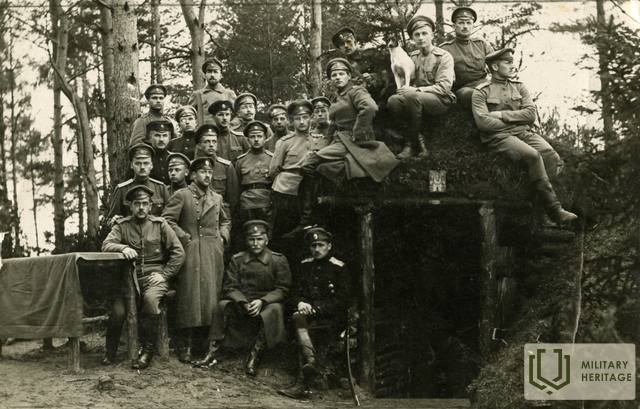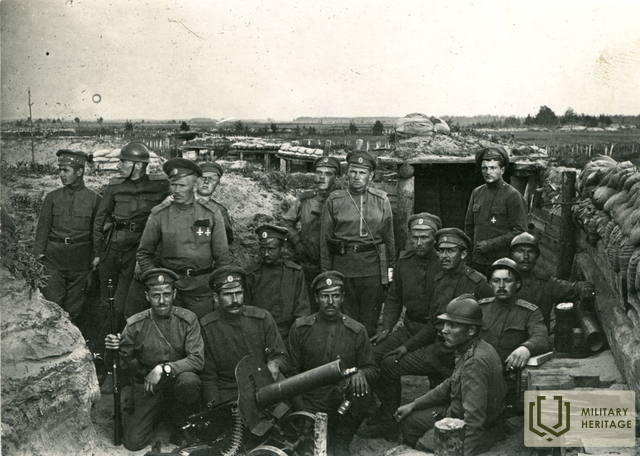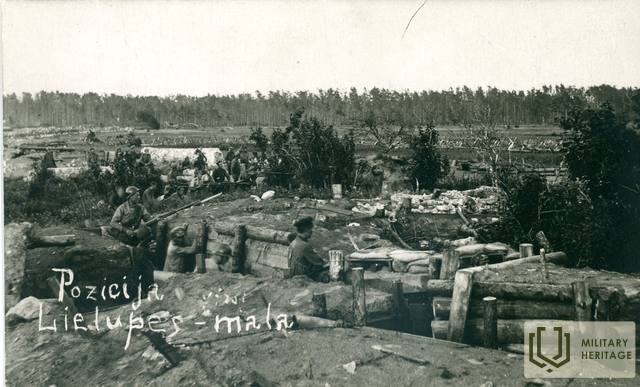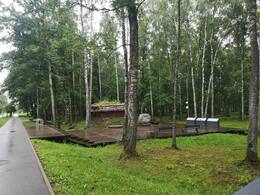Apie Latvijos lankininkus Olaines apylinkėse

Prisiminimuose atsispindi Latvijos lankininkų kasdienybė Olaine apylinkėse. Aprašomos ne tik gyvenimo sąlygos, bet ir įprasta užduotis – priešininko pozicijų žvalgyba.
(..) Nakvojome netoli mūšio lauko artilerijos prieglaudose. Ryte turėjome vykti į „Lapsami“, prie Olaines stoties, kur keletą dienų ir naktų praleidome po atviru dangumi, miške. Žinodami, kad vietoje teks pabūti dar kelias dienas, vyrai energingai ėmėsi molinių trobelių statybos. Dėl lentų trūkumo namelių durys iš pušies šakų. Laidų vyriams ir plytų krosnims buvo galima pilnai gauti apgriuvusioje Olaine stotyje, kur, kaip pasakojo kaimynai rusai, negalėjo eiti, nes vokiečiai matė ir šaudė. Maždaug po savaitės išvažiavome iš „Lapsų“ ir nuvykome į bataliono štabą, kuris buvo netoli Dove stoties. (..)
(..) Kai tik pasirodo vokiška raketa, nors jų apkasai yra kitoje pelkės pusėje, atsigulame. Ryte išeiname plona grandine. Mūsų treniruočių komanda yra dešiniajame trasos sparne. Kol pateksime į vokiečių apkasus, dar ilgai tenka vaikščioti per nedidelius apsnigtus krūmynus, su kiekvienu prisilietimu sniegas krenta už apykaklės, kojos įstringa purve, bet daiktų maišas nuplėštas nuo pečių. Eidami per krūmus būkite atsargūs, kad nenukryptumėte vienas nuo kito. Visą laiką girdime kulkosvaidžio šūvius kairiajame grandinės sparne, kur buvo įsikūrusi mūsų įmonė. Pradeda dirbti ir mūsų artilerija. Ari pradeda į mus šaudyti kulkomis. Kai kurie bėga pro šalį, kai kurie sprogsta priešais, atsitrenkę į medžio šaką. Mes nešauname, nes nematome priešo, o tiesiog einame į priekį. Be to, niekas nesislepia nuo priešo kulkų. Galime pradėti ir čia, nes „friči“ jau netoli. Prasidėjo intensyvesnis šaudymas. Netoliese išgirstu ilgai užsitęsusį aimanavimą, kuris tarp kulkų palieka slegiantį įspūdį. Vienas iš mūsų narių krito. Greitai jį nurengiame; krūtinėje matosi maža skylutė, pro kurią teka nauja gyvybė. Antrasis taip pat krenta. Prisimenu dvarininką iš Tukuma rajono, Mūris jau tada tikėjo Latvija ir jautė didžiausią neapykantą vokiečiams. Po mūšio jis buvo pasiklydęs. Tik kitą pavasarį rusų kareiviai rado jo kūną. Nevalingai ateina supratimas, kad visi tie, kurie labiausiai mylėjo latvių tautą - visi krito, pradedant Briežu ir baigiant nežinomu, nepastebėtu lankininku. Taip, jie turėjo šviesias sielas. Kertame miške iškirstą taką. Eime miegoti. Kai kurie drąsesni atsistoja. Vokiečiai nutilo. Prašėme savo vado, kad leistų pulti vokiečių apkasus, bet kadangi mūsų kuopos negalėjo pulti vokiečių apkasų, tai mums neleidžiama. Neturime ir pagalbinių pajėgų. Mes tik reta grandinė. Gulime ant lovos ir žiūrime. Štai vienas mūsų bendražygis, kritęs kovo mūšyje, narsus Kuržemės pilietis, šaudo. Matome, kaip virš mažų berželių ore skrenda vokiškas šalmas. Antru šūviu kitas bendražygis užmuša kitą vokietį. Du vokiečiai nešė dėžę šovinių. Matau, kad priešais krūme kažkas juda, sakau šalia esančiam draugui, kaip turėčiau šaudyti. Mes abu šaudome vienu metu. Iškart krūmai atsiskiria ir pasirodo senas vokietis kraujuojančia ranka, kuris šalmu ir smailia barzda daro įspūdį kaip mefistofelis. Ragina nešaudyti, nes namuose penki vaikai. Paėmėme jį į nelaisvę, bet prisilietimas buvo organiškas mainais. Jį išsivežė rusų kareiviai. Su savo palyginimu, gal aš darau jam meškos paslaugą, gal jis buvo sąžiningas šeimos žmogus, atitrūkęs nuo kasdienių darbų, bet tą akimirką paliko blogą įspūdį. Buvo ir po to atvejis, kai labai supykau dėl karo, matydamas sunkiai sužeisto priešo kančias. Bet visos tokios akimirkos galėjo palikti tik praeinantį įspūdį, nes vyko karas...
Laikraštis „Jēkabpils Vēstnesis“. 1925 metų sausis.
Susijusi laiko juosta
Susijusios vietos
WWI Historical Exploration Route and dugout
Located in Olaine, near the Olaine Museum of History and Art.
The historical route was established in 2018 at the site of the fortifications of the Russian army during World War I, which were part of the defense system of the area. The fighting between the German and Russian armies in the Olaine area attracts attention for several reasons. The marshy terrain prevented the warring parties from making rapid progress and required a variety of skills from the soldiers to operate in adverse conditions. Accurate terrain analysis, reconnaissance, and fortifications or engineering structures played an important role in the war.
Nowadays, the cognitive route is freely available and gives a rough idea of the living conditions of soldiers. The renovated buildings are closed, but can be seen by contacting the specialists of the Olaine History and Art Museum in advance.
Olaine History and Art Museum
The exhibit in the Olaine History and Art Museum is about the period of Soviet occupation in Olaine. A World War I exploration route with restored elements of the fortifications has been created in the territory of the museum. On the site, where the World War I Russian Army defence line once was, a Russian soldier-type dugout has been built and a fragment of a shooting tower can be viewed by visitors. A World War I reinforced concrete fortification can be seen in Jaunolaine, at the intersection to Plakanciems. During World War I, active battles were fought between the Russian and German armies in this area. Latvian Riflemen units were involved in intelligence and various other operations. Marshy lands made it difficult to defend, but this was a very important area in Latvian military history. Olaine was formed due to the convenient location between Jelgava and Riga, where Jaunolaine is currently located. The Olaine manor was nearby. The modern day Olaine was built during the Soviet occupation, when industrial companies began their operations there.








